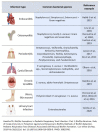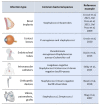The Current Knowledge on the Pathogenesis of Tissue and Medical Device-Related Biofilm Infections
- PMID: 35888978
- PMCID: PMC9322301
- DOI: 10.3390/microorganisms10071259
The Current Knowledge on the Pathogenesis of Tissue and Medical Device-Related Biofilm Infections
Abstract
Biofilm is the trigger for the majority of infections caused by the ability of microorganisms to adhere to tissues and medical devices. Microbial cells embedded in the biofilm matrix are highly tolerant to antimicrobials and escape the host immune system. Thus, the refractory nature of biofilm-related infections (BRIs) still represents a great challenge for physicians and is a serious health threat worldwide. Despite its importance, the microbiological diagnosis of a BRI is still difficult and not routinely assessed in clinical microbiology. Moreover, biofilm bacteria are up to 100-1000 times less susceptible to antibiotics than their planktonic counterpart. Consequently, conventional antibiograms might not be representative of the bacterial drug susceptibility in vivo. The timely recognition of a BRI is a crucial step to directing the most appropriate biofilm-targeted antimicrobial strategy.
Keywords: biofilm; clinical impact; devices; pathogenesis; tissues.
Conflict of interest statement
The authors declare that they have no conflict of interest.
Figures
Similar articles
-
Biofilm-related disease.Expert Rev Anti Infect Ther. 2018 Jan;16(1):51-65. doi: 10.1080/14787210.2018.1417036. Epub 2017 Dec 19. Expert Rev Anti Infect Ther. 2018. PMID: 29235402 Review.
-
Microbiological diagnosis of biofilm-related infections.Enferm Infecc Microbiol Clin (Engl Ed). 2018 Jun-Jul;36(6):375-381. doi: 10.1016/j.eimc.2017.04.006. Epub 2017 May 27. Enferm Infecc Microbiol Clin (Engl Ed). 2018. PMID: 28558916 Review. English, Spanish.
-
In Vitro Antimicrobial Susceptibility Testing of Biofilm-Growing Bacteria: Current and Emerging Methods.Adv Exp Med Biol. 2022;1369:33-51. doi: 10.1007/5584_2021_641. Adv Exp Med Biol. 2022. PMID: 33963526 Review.
-
[Biofilms and their significance in medical microbiology].Epidemiol Mikrobiol Imunol. 2002 Nov;51(4):161-4. Epidemiol Mikrobiol Imunol. 2002. PMID: 12532903 Review. Czech.
-
Clinical Impact of Antibiotics for the Treatment of Pseudomonas aeruginosa Biofilm Infections.Front Microbiol. 2020 Jan 9;10:2894. doi: 10.3389/fmicb.2019.02894. eCollection 2019. Front Microbiol. 2020. PMID: 31998248 Free PMC article. Review.
Cited by
-
Non-deacetylated poly-N-acetylglucosamine-hyperproducing Staphylococcus aureus undergoes immediate autoaggregation upon vortexing.Front Microbiol. 2023 Jan 9;13:1101545. doi: 10.3389/fmicb.2022.1101545. eCollection 2022. Front Microbiol. 2023. PMID: 36699608 Free PMC article.
-
Design of acidic activation-responsive charge-switchable carbon dots and validation of their antimicrobial activity.RSC Adv. 2025 Feb 18;15(7):5413-5425. doi: 10.1039/d5ra00174a. eCollection 2025 Feb 13. RSC Adv. 2025. PMID: 39967894 Free PMC article.
-
Medical Device-Associated Infections Caused by Biofilm-Forming Microbial Pathogens and Controlling Strategies.Antibiotics (Basel). 2024 Jul 4;13(7):623. doi: 10.3390/antibiotics13070623. Antibiotics (Basel). 2024. PMID: 39061305 Free PMC article. Review.
-
Culture Shock: An Investigation into the Tolerance of Pathogenic Biofilms to Antiseptics in Environments Resembling the Chronic Wound Milieu.Int J Mol Sci. 2023 Dec 8;24(24):17242. doi: 10.3390/ijms242417242. Int J Mol Sci. 2023. PMID: 38139071 Free PMC article.
-
Modulating the skin mycobiome-bacteriome and treating seborrheic dermatitis with a probiotic-enriched oily suspension.Sci Rep. 2024 Feb 1;14(1):2722. doi: 10.1038/s41598-024-53016-0. Sci Rep. 2024. PMID: 38302693 Free PMC article.
References
-
- Di Domenico E.G., Cavallo I., Sivori F., Marchesi F., Prignano G., Pimpinelli F., Sperduti I., Pelagalli L., Di Salvo F., Celesti I., et al. Biofilm Production by Carbapenem-Resistant Klebsiella pneumoniae Significantly Increases the Risk of Death in Oncological Patients. Front. Cell. Infect. Microbiol. 2020;10:561741. doi: 10.3389/fcimb.2020.561741. - DOI - PMC - PubMed
-
- Di Domenico E.G., Marchesi F., Cavallo I., Toma L., Sivori F., Papa E., Spadea A., Cafarella G., Terrenato I., Prignano G., et al. The Impact of Bacterial Biofilms on End-Organ Disease and Mortality in Patients with Hematologic Malignancies Developing a Bloodstream Infection. Microbiol. Spectr. 2021;9:e0055021. doi: 10.1128/Spectrum.00550-21. - DOI - PMC - PubMed
-
- Tascini C., Sozio E., Corte L., Sbrana F., Scarparo C., Ripoli A., Bertolino G., Merelli M., Tagliaferri E., Corcione A., et al. The role of biofilm forming on mortality in patients with candidemia: A study derived from real world data. Infect. Dis. 2017;50:214–219. doi: 10.1080/23744235.2017.1384956. - DOI - PubMed
Grants and funding
LinkOut - more resources
Full Text Sources




